NVIDIA 680i: The Best Core 2 Chipset?
by Gary Key & Wesley Fink on November 8, 2006 4:45 AM EST- Posted in
- CPUs
NVIDIA Control Panel & nTune 5
One of most interesting features at the nForce 500 launch was the revamped control panel and nTune 5.0 performance applications. The Control Panel and nTune have undergone some fine tuning the past few months with version 5.05 launching for the nForce 600 and GeForce 8800 series of products shortly. NVIDIA has combined all of their various program applets into an integrated control panel to provide a common user interface. We found that this common interface makes it easier for a user to control the various functions of the board and video (NVIDIA based) from a central access point.
The new control panel offers configuration sections for 3D Settings for NVIDIA GPUs, Display settings, Networking options, Performance, System Stability testing, Storage, and Video/Television settings. The information contained in each section will already be familiar to those with nForce4 or nForce 500 boards but will include a few extended configuration options for the nForce 600 and GeForce 8800 products.
One noteworthy change with the GeForce 8800 series is that Coolbits no longer works for overclocking the GPU. The overclocking panel will still be visible in the legacy control panel but it will tell you to download nTune in order to overclock your GPU. The new GPU overclocking utility works in the same manner but is now integrated into the revised Control Panel.
One of the more interesting features for us is the Adjust Motherboard Settings application. We found the ability to dynamically write a significant number of performance settings directly to the BIOS without requiring a reboot a very quick and easy way to test or set overclocking options without exiting Windows. There are several third party applications that perform this same function but we believe the official support within the BIOS and nTune software gives it a significant advantage over the other solutions. The settings can be saved in a profile that can be loaded within Windows without having to reset the BIOS for individualized situations where settings for games might differ from those for audio/video playback. The system also allows for automatic or direct fan control on supported fan headers.
The Dynamic BIOS Access section offers the ability to change BIOS setting in five different categories that will take effect on reboot. The two sections not displayed are for power management and peripheral settings.
If you are not the type to enter the BIOS and tune your system or set it up for overclocking then NVIDIA offers an application that can do it for you based on your combination of components. We found the Coarse Tuning option would generally set up our system for a 6%~9% overclock of the FSB and memory along with a 3%~5% overclock on the GPU. The Fine Tuning option resulted in an 8%~15% overclock of the FSB and memory while the GPU usually increased 5%~8%.
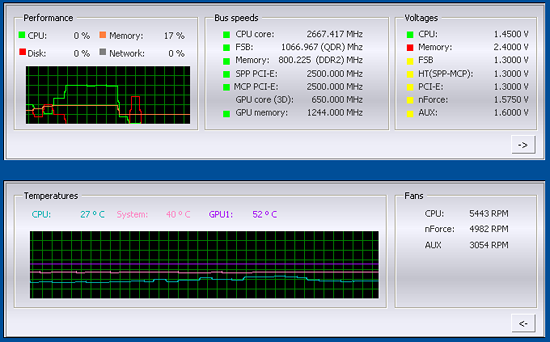
NVIDIA also includes a System Information utility along with a Windows based monitoring application. Overall, the polished look, feel, and operation of the new control panel along with the performance improvements offered in nTune 5.05 has raised the bar once again for user enhancements offered by the core logic suppliers.
One of most interesting features at the nForce 500 launch was the revamped control panel and nTune 5.0 performance applications. The Control Panel and nTune have undergone some fine tuning the past few months with version 5.05 launching for the nForce 600 and GeForce 8800 series of products shortly. NVIDIA has combined all of their various program applets into an integrated control panel to provide a common user interface. We found that this common interface makes it easier for a user to control the various functions of the board and video (NVIDIA based) from a central access point.
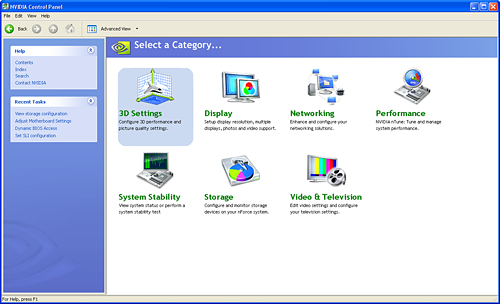 |
| Click to enlarge |
The new control panel offers configuration sections for 3D Settings for NVIDIA GPUs, Display settings, Networking options, Performance, System Stability testing, Storage, and Video/Television settings. The information contained in each section will already be familiar to those with nForce4 or nForce 500 boards but will include a few extended configuration options for the nForce 600 and GeForce 8800 products.
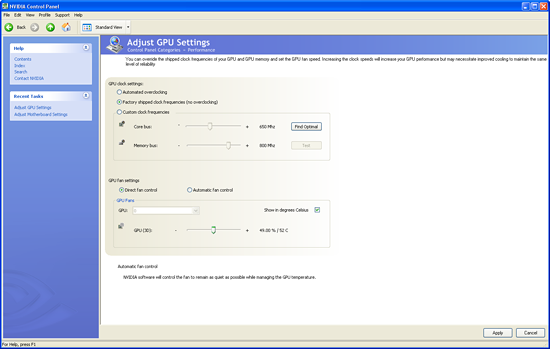 |
| Click to enlarge |
One noteworthy change with the GeForce 8800 series is that Coolbits no longer works for overclocking the GPU. The overclocking panel will still be visible in the legacy control panel but it will tell you to download nTune in order to overclock your GPU. The new GPU overclocking utility works in the same manner but is now integrated into the revised Control Panel.
 |
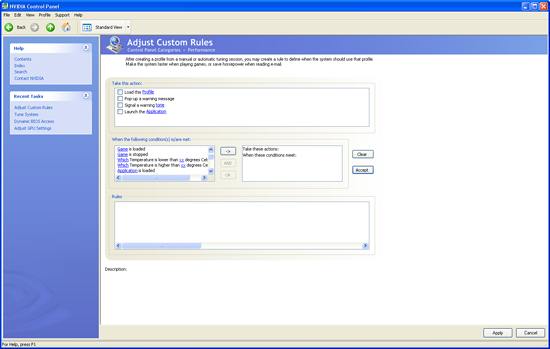 |
| Click to enlarge |
One of the more interesting features for us is the Adjust Motherboard Settings application. We found the ability to dynamically write a significant number of performance settings directly to the BIOS without requiring a reboot a very quick and easy way to test or set overclocking options without exiting Windows. There are several third party applications that perform this same function but we believe the official support within the BIOS and nTune software gives it a significant advantage over the other solutions. The settings can be saved in a profile that can be loaded within Windows without having to reset the BIOS for individualized situations where settings for games might differ from those for audio/video playback. The system also allows for automatic or direct fan control on supported fan headers.
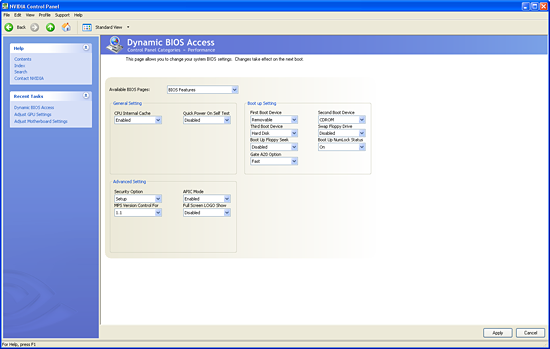 |
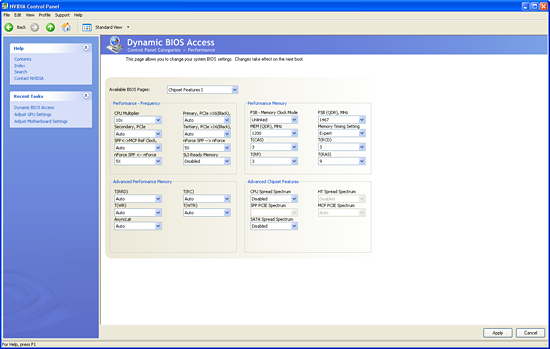 |
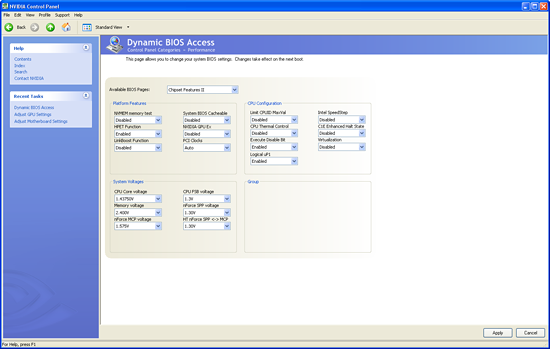 |
| Click to enlarge |
The Dynamic BIOS Access section offers the ability to change BIOS setting in five different categories that will take effect on reboot. The two sections not displayed are for power management and peripheral settings.
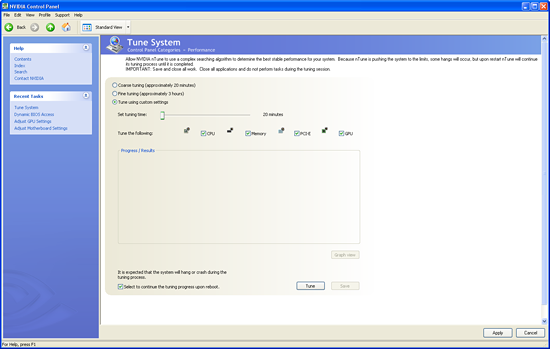 |
| Click to enlarge |
If you are not the type to enter the BIOS and tune your system or set it up for overclocking then NVIDIA offers an application that can do it for you based on your combination of components. We found the Coarse Tuning option would generally set up our system for a 6%~9% overclock of the FSB and memory along with a 3%~5% overclock on the GPU. The Fine Tuning option resulted in an 8%~15% overclock of the FSB and memory while the GPU usually increased 5%~8%.
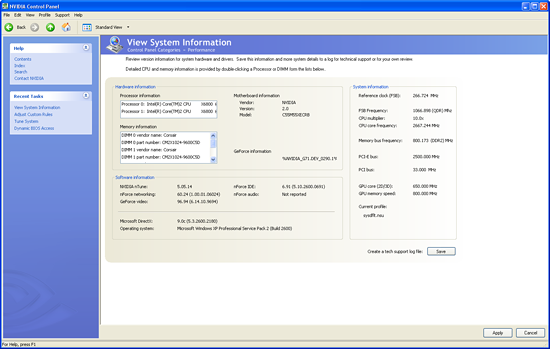 |
| Click to enlarge |

NVIDIA also includes a System Information utility along with a Windows based monitoring application. Overall, the polished look, feel, and operation of the new control panel along with the performance improvements offered in nTune 5.05 has raised the bar once again for user enhancements offered by the core logic suppliers.










60 Comments
View All Comments
Wesley Fink - Thursday, November 9, 2006 - link
The other time you might need a fan on the northbrdige is when using water cooling or phase-change cooling. There is no air-flow spillover from water-cooling the CPU like there is with the usual fan heatsink on the CPU, so the auxillary fan might be needed in that situation.Wesley Fink - Thursday, November 9, 2006 - link
The 680i Does NOT require active notrthbridge cooling and is shipped as a passive heatpipe design. At 80nm it is much cooler than the 130nm nVdia chipsets. The fan you see in the pictures is an included accessory for massive overclocking, much like Asus includes auxillary fans in their top boards.In our testing we really did not find the stock fanless board much of a limitation in overclocking as the northbridge did not get particularly hot at any time. We installed the fan when we were trying to set the OC record and left it on for our 3 days at 2100 FSB. Since it is a clip and 3 screws to install we left it on.
IntelUser2000 - Monday, November 13, 2006 - link
That's funny. A cooler running one consuming more power. Must be the die size is much larger :D.
yacoub - Thursday, November 9, 2006 - link
ah okay thanks for that clarification! =)yacoub - Thursday, November 9, 2006 - link
NTune would be a lot more interesting if it wasn't so slow to respond to page changes, cumbersome, and a gigantic UI realestate hog.The same functionality in a slimmer, more configurable, and efficient UI design would be highly desireable.
yacoub - Thursday, November 9, 2006 - link
and actually, that goes for the entire NVidia display/GPU settings configuration panel.Khato - Wednesday, November 8, 2006 - link
Each CPU is going to have a max FSB clock that it'll run stably at for the same reason that it has a max core logic frequency. The main difference here is that you have two possible barriers: signal degredation due to the analog buffers not being designed for such high speed and then whatever buffer logic there is in the CPU to clock cross from FSB to core not liking the higher frequency. I'm kinda leaning towards the buffer logic being the limiting factor, since I'd expect the manufacturing variance in the analog buffers to be minimal. That and the described 75MHz variance in top FSB frequency between various processors sounds reasonable for non-optimized logic.Staples - Wednesday, November 8, 2006 - link
I have no need for SLI. Makes the board more expensive and an SLI setup is just not worth it to me. I was about to buy a P965 chipset but now I am interested in a the 650i Ultra. Will we see a review of this chipset in the future? Most of it seems to be exactly the same as the 680i however it does lack some features and I am afraid that those missing features may affect performance. As it stands now, do you expect the performance of the 650i Ultra to perform identical to the 680i SLI?Gary Key - Wednesday, November 8, 2006 - link
We do not, we do expect the 650i SLI to perform closely to it. We will have 650i boards in early December for review. :)
Pirks - Wednesday, November 8, 2006 - link
is this functionality where you can overclock your CPU and FSB and memory on the fly without rebooting Windows available only on nForce mobos? I'm a stability freak and I want to be able to raise and lower my clocks and voltage on the fly, similar to the way Macs do this - they spin their fans under load and become totally quiet when idle - I wanna do the same so that my rig is dead quiet when idle/doing word/inet/email/etc and becomes noisy and fast OCed beast when firing up Crysis or something. and I want this Mac-style WITHOUT rebooting Windowsso do I have to buy nVidia mobo for that?
600i series only or earlier nForce 4 or 5 series will do as well?
I still can't dig what's up with these "dynamic BIOS updates that _require_ reboot to work" - so can you OC without rebooting or not? if yes - what are these BIOS options that nTune changes that DOES require reboot?
could you happy nTune owners enlighten me on that stuff? thanks ;)